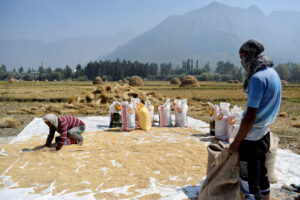Which healthcare center will help more people: Primary care facilities or specialty hospitals?

On Aug. 24, President Ferdinand Marcos, Jr. signed in a bill mandating the establishment of specialty centers in Department of Health (DoH)-run hospitals and in government-owned or -controlled corporation (GOCC) hospitals in the country. Republic Act (RA) 11959 or the “Regional Specialty Centers Act” aims to ensure accessible and affordable healthcare services for all Filipinos.
Under the law, the DoH is designated to establish specialty centers in every region and in GOCC specialty hospitals, giving priority to the care of patients afflicted with cancer, cardiovascular, lung, renal, brain, and spine diseases, and trauma and burn cases. GOCC specialty hospitals include the Philippine Heart Center, the National Kidney and Transplant Institute, the Lung Center of the Philippines, and the Philippine Children’s Medical Center.
The specialty centers shall also prioritize orthopedic care, physical rehabilitation medicine, infectious disease and tropical medicine, toxicology, mental health, geriatric, neonatal, dermatology, eye, ear, nose, and throat care. At the instance of Batanes Rep. Ciriaco Gato, Jr., an ear, nose, and throat surgeon, ENT centers were included in the law. Said he, “As an ENT surgeon, I have seen how a simple infection resulting from minor issues can escalate into something serious due to lack of accessible specialized care.”
According to Senate President Juan Miguel Zubiri, the Regional Specialty Centers Act would provide medical access and convenience to millions of Filipinos outside Metro Manila. “The idea is to bring the Heart Center, Kidney Institute, Lung Center and Children’s Medical Center closer to the public in Luzon, Visayas, and Mindanao. The transportation cost of going to Manila as well as accommodation is too much,” Mr. Zubiri said.
“Patients from all over the country travel to Manila to seek medical help from these specialty hospitals because the treatment that they require are usually not available at the medical facilities where they reside or are too costly for them. Eventually, we want to bring these services closer to them with the establishment of satellite specialty hospitals,” Senator Sonny Angara added.
According to the Health department, as of 2022 the DoH manages 66 hospitals. Of these, only 36 are Level 3 hospitals or what are commonly referred to as general hospitals. Because of their existing physical facilities, equipment, and medical staff, Level 3 hospitals are the only hospitals that can readily be converted into specialty centers.
Level 3 hospitals are staffed by specialists in family medicine, pediatrics, obstetrics-gynecology, surgery, departmental clinical services, with respiratory units, general ICU, high-risk pregnancy units, dental clinics, teaching/training with at least two accredited residency programs for physicians in any medical/surgical specialty and/or subspecialty, physical medicine and rehabilitation units, ambulatory surgical clinics, and dialysis clinics.
Some of them, like the 1,500 bed Southern Philippines Medical Center in Davao City, may already have cardiovascular and kidney specialists. The services of the 1,000+ bed Vicente Sotto Memorial Medical Center in Cebu City includes cancer treatment. A P10-billion specialty complex like the one being developed in Clark, Pampanga need not be built in some regions.
Level 3 hospitals are located in the most urbanized and commercialized cities of the regions, except in Region I, where the government-owned and -controlled Level 3 hospital is in Batac, Ilocos Norte, not in Dagupan City, Pangasinan. Of the 15 regions, only Region XIII (Caraga) does not have a Level 3 or general hospital.
The location of regional specialty centers in those major cities negates the statements of President Marcos, Senate President Zubiri, and Senator Angara that the specialty centers would provide medical access and convenience to millions of Filipinos. The rural folks of Ilocos, the Cordillera, Cagayan Valley, Mimaropa, Bicol, the Visayas, and Davao regions still have to travel some 100 kilometers or more across mountains or channels to get to the major city where the specialty center is.
Also, services provided by the specialty centers will not be free but will be on a fee-for-service basis as in the Philippine Heart Center, although at rates lower than those charged by private hospitals like St. Luke’s. I know of a person who spent P835,000 for a quintuple bypass in the Philippine Heart Center in 2013. A kidney transplant costs more than that. Therefore, only the landed gentry, provincial business moguls, and political warlords would be able to afford the services of the regional specialty centers. Poor folks would just stay in their huts or shacks, treat themselves with herbal remedies or consult the neighborhood arbolaryo.
Cardiologists, oncologists, nephrologists with advanced training and long experience, and skilled surgical oncologists, thoracic surgeons, and kidney transplant surgeons, having built a lucrative practice and attained prominence in society, would most probably be living a lavish lifestyle. I wonder how many would be willing to relocate to places like Tuguegarao, Batangas City, Tacloban, Butuan, and Zamboanga City, which are among the likely sites of specialty centers.
The amount necessary for the initial implementation of the law will be charged against the current year’s appropriation of the DoH and will include in its program the establishment and operationalization of the specialty centers in its annual budget thereafter. The specialty centers will save hundreds of lives all right, but it will be the lives of the affluent and the powerful in the provinces.
But hundreds of thousands of lives will be lost because the appropriation of the DoH for the development of hundreds of primary care units in the rural areas — as mandated by Republic Act No. 11223, An Act Instituting Universal Health Care for All Filipinos — will be diverted to the establishment of the 14 other regional specialty centers.
The Universal Health Care Act was meant to save lives by providing the medical attention people need when they need it at a cost affordable to the farmers, fishers, cottage industry workers, pedicab drivers, market vendors, and sari-sari store attendants in the countryside. Universal healthcare will work only if there are primary care providers. Primary healthcare ensures people receive comprehensive care, ranging from promotion and prevention, to treatment, rehabilitation, and palliative care as close as feasible to people’s everyday environment.
Primary care units provide the first point of contact in the healthcare system. Folks from rural areas can access a wide variety of health services: preventive care and screenings; care for chronic conditions such as asthma, hypertension, and diabetes; and acute care for problems like coughs, digestive issues, and high fever. Causes of death among children are diarrhea, bronchitis, measles, malnutrition, and pneumonia. Other sicknesses are skin allergies, sore eyes, influenza, chicken pox, and respiratory infections.
The primary care doctor can detect early any health issue like high blood pressure, diabetes, heart disease, pediatric ailments, infections, and care for open wounds, and can determine whether the patient is at increased risk for more serious conditions and can help him or her to take steps to prevent them from developing. The simple infection resulting from a minor issue that Rep. Gato had seen many times would not have escalated into something serious had there been primary care facilities.
A primary care unit can be a six by eight-meter structure with space for consultation and for lying-in care, and a washroom/toilet. It would have a hand water pump and a water storage tank to provide running water. The facility would also have office tables, chairs, and beds. The number of beds would depend on the population of the community the primary care unit shall serve. The World Health Organization recommends that there should be two beds per 1,000 population.
A primary care unit would have a duly licensed physician and a support staff — a nurse, if available, or a midwife/caregiver trained for the effective delivery of primary care services. It would have available operational equipment, instruments, materials, and supplies consistent with the services it would provide.
Graduates of the schools of medicine of state universities can be required to practice for a year or two in the rural areas, if they are not already required by law. Almost all regions have a state university with schools of medicine and related healthcare fields. Primary care units can draw their physicians and support staff from those schools. And, of course, there are those who take up medicine for humanitarian reasons. They would gladly spend their entire professional life caring for the folks in the countryside.
If the budget for a specialty hospital center is used instead for the construction and operation of primary care facilities, hundreds of them can be set up to serve the millions of people who have no access to healthcare service and thus save hundreds of thousands of lives.
Oscar P. Lagman, Jr. is a retired corporate executive, business consultant, management professor and an avid sports fan.




